Across the Garden of Life -Durch den Garten des Lebens - À travers du Jardin de la Vie -Pelo Jardim da Vida -Por el Jardín de la Vida - من حديقة الحياة - החיים
Wednesday, December 24, 2014
Wednesday, July 2, 2014
When Life Gives You Tornadoes, Make Bouquets!

Posted July 2, 2014 by laurabruno in Uncategorized. Tagged: El Mundo Bueno, Fifth Sacred Thing, Flowers, Human Evolution, Reality Creation, Tornadoes. 8 Comments
I'm not sure if last night's weather made national news, but just wanted to let people know that we are OK here in Goshen after a night of storms and possible tornado touchdown. I did my usual property protection with the THORN Rune, Nature Spirits and visualization, and once again, almost no signs of a storm on our block. What's strange is that the little "damage" we had, I dreamed on Sunday morning! Poor Ann, of Exopermaculture got an eye-full of an email from me on Sunday, as I had intended to ask her a simple question anyway about watering the Garden Tower, but instead awoke from an extremely vivid dream about what appeared to be the New Madrid earthquake.
In the dream, I watched the ground beneath our Garden Tower heave-ho, to and fro until the Garden Tower actually tipped over. Everything was eerily quiet in the dream, and the only real loss turned out to be that the GT had squashed a ripe watermelon. In sharing the dream with Ann, I mentioned that the watermelon in question was only a few inches now. Well, after last night's crazy storms — telephone poles cut in half, trees down all over the county, 60K people, including us, without power most of today — the only real "damage" I saw outside today was that the watermelon from my dream had been catapulted off its little cradle when a pot of mint tipped over.
Amidst all the blowing, the exact watermelon from my dream (just a younger version of it) met its demise. Hopefully that means the tornado substituted itself for what would have been a devastating earthquake at the fault line if it rocked the ground so much up here. ;)
I don't mean to minimize the effects of the tornado. People described trees "all over the place," broken store windows, and much of downtown Goshen remained closed all day today. My friend Kimber stopped by this morning to see how we fared, sharing that her garden, too, had largely weathered the storm. On her way to our house, she observed many downed trees that had carefully inserted themselves between houses so as to cause the least amount of structural damage possible. We expressed gratitude that the tree right next door to us — about 5 stories high and hollow, according to our mulch guy — made it through yet another storm. It's unlikely ever to hit our house if it goes, but one direction would mean a 60,000 volt impact on power lines that supply the North end of town (where Kimber lives); the other direction would demolish our neighbors' house and possibly part of our front yard garden. You can bet that tree received extra protective attention last night!
People around town today shared being awoken by their cell phones blaring tornado warnings, as well as the town's tornado sirens. Being so used to the train whistles all night, we, of course, heard none of that here. David slept through the whole thing, and I sleep so earplugged, lavendered and with the white noise of the vintage Hassock fan that I'm "lucky" if I hear David's alarm each morning. I did awake at 1 a.m. with a sudden knowing to unplug the stereo, since we'd already done our laptops before bed. By then, incredible lightning and winds had started, so I began Rune protections and full concentration. Once things settled down, I fell back asleep, awakening two hours later due to the unusual silence of having the power out. It remained out until around 4:45 p.m. today.
All in all, though, this storm seemed yet another example of "being in the world but not of it" or of radically diverging realities — one negative and the other new and celebratory. Kimber arrived to find me gathering bouquets in my nightgown, wellies and a light sweater — zinnias and yarrow in hand. When I went outside to survey the "damage," I had found only a tipped over geranium pot, the one rogue watermelon, and a couple pots of mint on their sides. Nothing broken, just a wild mass of electrified, happy, brilliant plants! I felt compelled to gather flowers for one new bouquet to replace the older one I'd just composted.
As I continued to look around, I noticed that some of the taller flowers and leeks I'd let flower were spread out and somewhat drooping. They hadn't detached, but their tall, heavy stems encouraged me to lighten the load with two more bouquets. I ended up finally staking some of the plants that had asked me to stake them earlier this week (oops!), but really, all I got for my negligence was an extra two spots of loveliness:

And, oh, my! These stems were so long, they needed background support. Confession: I have long been a fan of bathroom bouquets. :)
As synchronicity would have it, I had very few sessions scheduled today and had just had a dry run wifi outage last Thursday, leading me to have prepared to do any phone sessions via cell "if necessary." I even got to use a handy dandy cell solar charger from my prepper postal friend, Sean. It's too funny that I always, always get him whenever I go to the P.O., and we always happen to have just the right info or product that the other of us has been looking to learn or acquire. Anyway, now I can finally tell him that I opened the box!
As with that 6/14/14 date, which seemed another reality splitter, today marked an especially wonderful day in David's world — and thus, by extension, my own. Without going into private details, we received two additional confirmations of long awaited changes that will dramatically free up his life in very much imagined and intended ways. He had a half day today and picked me up to run errands in a part of town unaffected by power outages. Since cell phone conversations (even with headset, Qlink, and a SARS shield) still zap me with EMF's, I felt famished and even a little shaky. (The orgone pucks have dramatically helped with our in-home wifi, but, I tell you, those iPhones are toxic! I really do feel like I have radiation sickness whenever I talk on them for any length of time, even with all the protections. That's not to say the protections don't work. Without them, I cannot even have my phone turned on, let alone talk on it.)
Anyhoo, I mentioned how hungry I was, so David made a beeline decision to turn into Goshen's new Thai restaurant we've meant to try. We had heard very mixed reviews and didn't know what to expect. Lo and behold, we had a fabulous lunch! Artistic presentation, delicious vegan food, lovely waiter. Thank you, thank you!
We then continued on our errands and eventually took a short nap at David's parents' air conditioned house (I hadn't slept much last night), since they had power. When we returned to our house, the compost bin I'd recently ordered for our next door neighbors arrived, our power was on, and I just needed to await delivery of a different compost bin for us, which I had scored for very cheap on Craigslist. I've been looking for a second compost bin just like our current one for months, and they're either unavailable or very steeply priced. I got both of today's bins for about half the cost of what a single one would have cost. Their arrival so close to each other after months of searching on today, the same day David learned his wonderful news … just underscored the contrast between disaster and joyful timelines.
If you've felt insane intensity this last little while, you're not alone at all. I hear from people all over the world each week, sharing statistically improbable successes and bizarre challenges that you just can't make up if you want to write a believable novel. It continues to become ever more clear that what Starhawk calls El Mundo Bueno and El Mundo Malo live side by side.
In magical realist terms:
"Doña Elena used to say that there was the Good Reality, El Mundo Bueno, literally the Good World, and the Bad Reality, El Mundo Malo, and they were always vying with each other. In the Good Reality you have a mild headache; in the Bad Reality you have a fatal brain disease. In the Good Reality, you catch hold of the rail as your foot slips; in the Bad Reality, you miss, slide down the stairs, and break your neck.
"We walk in the Good Reality as if we were treading the thin skin on warm milk. It's always possible to break through and drown. …
"There is a hopeful side to Doña Elena's teaching. … Even in El Mundo Malo, the Good Reality is always just on the other side of the surface of things. If you can learn to reach and pull yourself through, you can make miracles." (Starhawk, The Fifth Sacred Thing, page 44)
Each person gets to decide, moment by moment voting with attention, intention and vibration — which will it be? I say: "When life gives you tornadoes, make bouquets!"
Cheers, Lovies!
Related
Gratitude, Gardens and Good VisitIn "Ann Kreilkamp"
Gratitude for the Nature SpiritsIn "Derecho"
Happy Spring!In "Faeries Garden"
A Recipe To Make Cannabis Oil For A Chemotherapy Alternative
Posted: 01 Jul 2014 12:51 AM PDT
by Arjun WaliaCollective Evolution
Awareness with regards to cannabis as a treatment and potential cure for cancer has been rapidly increasing over the past few years. Several studies over the last decade have clearly (without question) demonstrated the anti-tumoral effects of the plant. Cannabinoids (any group of related compounds that include cannabinol and the active constituents of cannabis) activate cannabinoid receptors in the body. The human body itself produces compounds called endocannabinoids and they play a very important role in many processes within the body to help create a healthy environment.
Since radiation and chemotherapy are the only two approved treatments for cancer, it's important to let people know that other options do exist. There's nothing wrong with exploring these options and finding out more information about them so people can make the best possible choice for themselves. It's always important to do your own research.
A number of people have used this treatment to help treat their cancer. The latest article we wrote is a great example (amongst many), where a 9-year-old girl used cannabis to cure her cancer. You can read more about that HERE.
As more become aware of the healing power that this plant has, the next question to be asked is how is it used? Linked above (second from the top) is an article titled "Teenage Girl Uses Cannabis To Treat Leukaemia & Great Results Were Seen," you can click on the case study embedded within the article and email the doctors, hopefully they can answer your questions if it is an emergency.
Read more »
Tiny Housing contd..
Bruce's Airstream Overlander
Bruce Czopek is a muralist, artist and avid backpacker who decided about two years ago to stop paying rent. While the costs of home ownership were out of his reach—he still wanted to own something that he wouldn't have to worry about losing should he not be able to pay the rent. Enter a 26-foot 1966 Overland Airstream. […] Continue Reading »
Thursday, June 26, 2014
Tiny Houses Contd. 06.236.2014
Moroccan Tiny Houses
Because of the heat of the desert, homes have to keep both humans and animals cool and many of the homes you see are still built the traditional way. Bricks made with mud, sand and straw (sometimes animal dung) are laid out in the sun to dry. They are then stacked on top of a stone foundation and covered with mud plaster. Many of the homes don't have windows, but instead have intricate metal grates for safety and airflow. […] Continue Reading »
-----------------------------------------------------------------------------------------------------
Hob-Nobbin from Hobbitat Spaces
A day in the life of our friend Colin. From a hob to the great outdoors of Garrett County and back. Not too shabby. This 425 square foot cabin is eco friendly, featuring recycled heart pine from the Carnegie Railroad shed. […] Continue
Vlad's Tiny House
A couple that I freelanced for, designing ads and catalogs, had been remodeling a tiny house, so I just had to get over there and get a tour. Wow, they took a 12 x 24 ft. building with a loft and parked it on their property, added a front porch and two permanent overhangs that are used as a cook out area on one side and a place to park on the other. […] Continue Reading »
My Yotel Experience
The Tiny House Blog has featured the Yotel airport hotel pods before and this time I had a chance to stay in one at Heathrow Airport in London. These convenient sleeping pods located in London, Amsterdam and New York give you the option for a more peaceful layover while combining space saving designs, Japanese esthetics and a hint of Star Trek. […] Continue Reading »
New Issue 18 |
Zu viele Newsletter? Sie können das Abonnement kündigen. |
Laura Bruno's Solstice gardening
Garden Update from Summer Solstice by laurabruno
| Re-blogged from Laura Bruno's Blog |
I spent the morning of Summer Solstice finally — after nearly a year — putting pots of gifted black raspberry bushes into the ground. Those guys are spiky, and I just couldn't for the life of me decide where to locate them, since I really want to add three serviceberry trees and two Nanking cherry bushes along the side fence where it would have made sense to grow them as a thorny hedge. Anyway, they went into the ground on Solstice, where they await installation of a small trellis and my next load of wood mulch. It's sad that it took an Earth holy day for me to get them in the ground, but it also felt like a great way to honor the day:
I'm starting to get the hang of succession planting and harvesting, so last Fall's garlic came out, in order to make room for bush beans and the Brussels sprouts taking over the "Guarden" Bed. I harvested several more bulbs after this, and holy, moly does our basement smell like garlic! Wowzers, that's potent stuff before it dries!
I took the rest of these photos in the afternoon on Solstice before David and I went out for a little celebratory dinner. We've had so much rain since then that everything has noticeably grown, but guess what? It's raining again now, so these photos go up. Meanwhile, the trend continues of me amending the soil with rock dust and compost and then an unscheduled rain shower washing it all in. Thank you, faeries and Nature spirits! :)
Front beds from driveway, looking North
Our butterfly garden continues to grow on the far North side of the front yard. Milkweed, zinnias, liatris, dill, yarrow, sunflowers, dianthus and more continue to grow in preparation for Monarch season.
Some Fairy Tale Pumpkins have finally taken, and they're growing well. The fava bean bushes came out yesterday, because rain finished them off, making room for pink okra.
Our cantaloupe have reached across the aisles.
If you look closely, you can even see some watermelon already growing.
I love the afternoon light in the backyard! (And yes, that busted out garage roof has inspired much of my vertical gardening. Little do the neighbors know, but they will soon be getting paw paw trees, too, if I have anything to do with it. There's more than one way to hide an eyesore!)
Lots of areas ready for more wood mulch, but overall, the gardens themselves are growing well.
I spoke to one of our neighbors in the blue house today, and he's very excited for the soon to be arriving compost bin I bought them last night. Apparently, they throw away "tons" of food scraps, and they're excited to contribute to the constant need for compost. I love how our yard has become a community hang out for the neighbors and their friends. Not only have they planted zinnias by their front porch, but the kids also planted some sunflowers in the backyard. They've had a very late start, but they are growing. It's great to see the kids having friends over and really noticeable how they now hang out near the front gardens with all the flowers. Before I started gardening, this yard was such an eyesore that we never really saw them hanging out much here.
Flowers! They really make a difference, even in the ugliest environment — beautifying not just landscapes, but lives.
Many blessings!
Monday, June 16, 2014
Collection about Tiny Houses and Tiny Housing
Big Sky Retreat Yurt
Scott Evans shared his Big Sky Retreat in a post on the Tiny House Blog a year or so ago. His 17 year old daughter Alison "Red" Evans recently filmed an excellent video on the retreat that I wanted to share with you. The yurt building is mainly constructed out of scrap scaffold boards, pallets and timber from the builders merchants. It cost around £10,000 (about $15,979) not including labour time. […] Continue Reading »
------------------------------------------------------------------------------------------------------------
Tina Larkin and her Purple HarpMobile
I'm a musician, visual artist, traveler and dog lover. As long as I can remember, I've always been interested on living simply and having a small carbon print upon the Earth. I always wanted some sort of teardrop or small RV in order to have a home on wheels. […] Continue Reading »
------------------------------------------
Living on the Grid in a Tiny Space
I have always been intrigued by small spaces and when I was stationed in West Berlin in the early 80's, I noticed that the people there had little "Gardenplatz" structures in a certain area in the city specifically set aside for that. These were little cabins in a fenced in area where the owners could take a little holiday and do some gardening. They grew flowers and vegetables there. […] Continue Reading »
-----------------------------------------
Tiny Red
How I stumbled upon the Tiny House Blog I don't remember, but I became fixated with all the darling miniature houses and happy, free-spirited people living in them. I could not believe that houses could be built on wheels. Such a great idea! I pictured myself living in one, imaging where my furniture would go. Each day, I eagerly devoured the stories. […] Continue Reading »
Thursday, June 12, 2014
52 Wild Plants You Can Eat – Updated
Waking Times and re-blogged from there to here
Editor's Note: This list is originally from Suntactics, however, Waking Times has added important addendums to this information and has corrected some errors. If you have any additional insight to share, please do so in the comments section below, and we can assemble another version of this article once more input is taken.
In addition to using the list below as a resource, consider the importance of properly educating yourself before consuming wild plants. Below are some resources to consider:
Stalking the Wild Asparagus and Stalking The Healthful Herbs by Euell Gibbons
Edible Wild Plants by John Kallas Ph.D.
Wild Cards: Edible Wild Foods and The Essential Wild Food Survival Guide by Linda Runyon
We all know which vegetables and fruits are safe to eat, but what about other wild edibles? Here are a few common North American goodies that are safe to eat if you find yourself stuck in the wild:
Blackberries - Rubus fruticosus

Many wild berries are not safe to eat, it's best to stay away from them. But wild blackberries are 100% safe to eat and easy to recognize. They have red branches that have long thorns similar to a rose, the green leaves are wide and jagged. They are best to find in the spring when their white flowers bloom, they are clustered all around the bush and their flowers have 5 points. The berries ripen around August to September.
Dandelions - Taraxacum officinale

The easiest to recognize if the dandelion, in the spring they show their bright yellow buds. You can eat the entire thing raw or cook them to take away the bitterness, usually in the spring they are less bitter. They are packed with Vitamin A and Vitamin C, and beta carotene.
Asparagus - Asparagus officinalis
The vegetable that makes your pee smell funny grows in the wild in most of Europe and parts of North Africa, West Asia, and North America. Wild asparagus has a much thinner stalk than the grocery-store variety. It's a great source of source of vitamin C, thiamine, potassium and vitamin B6. Eat it raw or boil it like you would your asparagus at home.
Elderberries - Sambucus

An elderberry shrub can grow easily grow about 10 feet and yield tons of food, their leaf structure is usually 7 main leaves on a long stretched out stem, the leaves are long and round and the leaves themselves have jagged edges. These are easiest to identify in the spring as they blossom white clustered flowers that resembles an umbrella. Mark the spot and harvest the berries when they're ripe around September.
Elderberries are known for their flu and cold healing properties, you can make jelly from them and are very sweet and delicious. Yet, be aware that elderberries can be toxic if not properly prepared.
Gooseberries - Ribes uva-crispa

These are also common in the woods in northern Missouri, the branches are grey and have long red thorns, and the leaves are bright green and have 5 points. They have rounded edges and look similar to the shape of a maple leaf. The flowers in the spring are very odd looking, they are bright red and hang down, the berries ripen around late May early June.
Mulberries - Morus
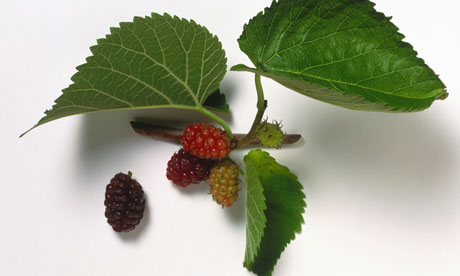
Mulberry leaves have two types, one spade shape and a 5 fingered leaf. Both have pointed edges. The ripe fruit is edible and is widely used in pies, tarts, wines, cordials and tea.
Pine - Pinus

There are over a hundred different species of pine. Not only can the food be used as a supply of nourishment but, also can be used for medicinal purposes. Simmer a bowl of water and add some pine needles to make tea. Native americans used to ground up pine to cure skurvy, its rich in vitamin C.
Kudzu - Pueraria lobata

Pretty much the entire plant is edible and is also known for medicinal values, such as being an anti-inflammatory and helping in treating headaches and migraines. In developed areas, these plants are often sprayed with herbicides. We were blessed to find this great patch of Kudzu surrounded by Blackberries. The leaves can be eaten raw, steam or boiled. The root can be eaten as well.
Daylily - Hemerocallis

You can find this plant in many parts of the country, they have bright orange flowers and foliage that comes straight up from the ground, no stem. You can eat the flower buds before they open, just cook it like a vegetable.
Pecans - Carya illinoinensis

The trees mature around 20-30 ft, some can grow up to 100 ft tall. The leaves are bright green and long, smooth edges and the pecans themselves are grown in green pods and when ripe the pods open and the seeds fall to the ground. The pecan is a species of hickory, native to south-central North America. Pecans, if grown commercially have some of the highest nutrients per acre of any crop.
Hazelnuts - Corylus

Hazelnut trees are short and tend to be around 12-20 ft tall, the leaves are bright green and have pointed edges, and the hazelnuts themselves grow in long strands of pods and generally ripen by September and October. They are also known as cobnut or filberts.
Walnuts - Juglans regia

Walnut trees are the most recognisable and the tallest nut tree in North America, they can range from 30-130 feet tall. The leaf structure is very similar to the peacan, the leaves are spear like and grow on a long stem 6-8 leaves on both sides. The leaves edges are smooth and green. The walnuts tend to grow in clusters and ripen in the fall.
Acorns - Quercus

Acorns, also known as oak nuts, can tend to be bitter, they are highly recognisable. They should be eaten cooked and a limited amount.
Hickory Nuts - Carya

Hickory nut trees can grow about 50-60 ft tall, their green leaves are spear like and can grow very large, they have pointed edges. The hickory nut is round and ten to ripen in September or October.
Clovers - Trifolium repens
Clovers are everywhere if you're lucky *pun*, and edible! If you find grass you will most likely see this sprouting everywhere, their distinctive trifoil leafs and white flowers are easy to spot, you can eat them raw but they taste better boiled.
Red Clovers - Trifolium pratense

Blossoms can be eaten fresh or steeped in hot water for tea. And you can toss both the green leaves and blossoms into a salad.
Chicory - Cichorium intybus
You can find these in Europe, North America and Australia. The entire plant can be eaten along with it bright blue flowers, which can also be white or pink. Chicory is well known for its toxicity to internal parasites.
Coltsfoot - Tussilago farfara
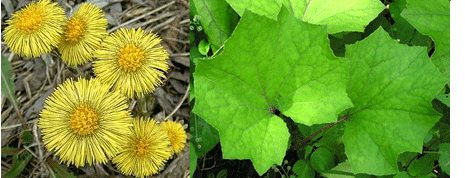
Edible parts: Flowers and young leaves can be eaten. Flowers can be eaten raw and mixed into a salad adding a wonderful aromatic flavor. Use the flower head and place them into a glass jar adding raw honey and storing it for a few weeks for its strength; this makes a great home remedy to help calm a cough, or just add some of this coltsfoot honey into your tea. You may dry the flower heads and use them as tea or in cooking/baking recipes. Young leaves are bitter but better after boiled them and then in salads, stews, or just add lemon, extra virgin olive oil and seasoning.
Although coltsfoot is well documented as a natural cough and sore throat remedy, it may be best to avoid prolonged use of the plant or to ensure the supplement you buy is certified and labeled as hepatotoxic pyrrolizidine alkaloid free (PA-free). Hepatotoxic PAs might be carcinogenic and mutagenic and may also increase blood pressure. Certain studies have shown that Coltsfoot tea causes liver problems in infants and pregnant women.
Creeping Charlie - Glechoma hederacea

Edible parts: Young leaves can be eaten raw or cooked. The leaves have a mild bitter flavor with a aromatic tang great for salads or jucing. You can cook these young leaves like spinach, or add to soups, stews, and omelet. Tea is made from the fresh or dried leaves. This wild edible has been known to be added to beer in much the same way as hops, for flavor and clarity. This plant is also known as ground-ivy, gill-over-the-ground, alehoof, tunhoof, catsfoot, field balm, and run-away-robin.
Cattail - Typha latifolia

Known as cattails or punks in North America and bullrush and reedmace in England, the typha genus of plants is usually found near the edges of freshwater wetlands. Cattails were a staple in the diet of many Native American tribes. Most of a cattail is edible. You can boil or eat raw the rootstock, or rhizomes, of the plant. The rootstock is usually found underground. Make sure to wash off all the mud. The best part of the stem is near the bottom where the plant is mainly white. Either boil or eat the stem raw. Boil the leaves like you would spinach. The corn dog-looking female flower spike can be broken off and eaten like corn on the cob in the early summer when the plant is first developing. It actually has a corn-like taste to it.
Garlic Mustard - Alliaria petiolata
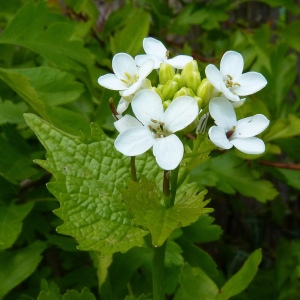
Edible parts: Flowers, leaves, roots and seeds. Leaves can be eaten in any season, when the weather gets hot, the leaves will have a taste bitter. Flowers can be chopped and tossed into salads. The roots can be collected in early spring and again in late fall, when no flower stalks are present. Garlic mustard roots taste very spicy somewhat like horseradish…. yummy! In the fall the seed can be collected and eaten.
Chickweed - Stellaria media

These usually appear May and July, you can eat the leaves raw or boiled, they're high in vitamins and minerals!
Hop Clover - Trifolium campestre
Edible parts: The flowers, leaves and seeds are edible. All clover types are known to be part of the paleo diet of the First Nations people. Flowers can be put into teas. Seeds (in autumn) can be collected and eaten as is or roasted and can be ground into flour as well. Leaves can be tossed into salads, omelets, juicing, sandwiches, etc.
Herb Robert - Geranium Robertianum
Edible parts: The entire plant. Fresh leaves can be used in salads or to make tea. The flower, leaves and root can be dried and stored using it later as a tea or herbs as a nutrient booster. Rubbing fresh leaves on the skin is known to repel mosquitoes, and the entire plant repels rabbits and deer which would compliment and protect your garden. For more info about Herb Robert see HerbsAreSpecial.com.
Beach Lovage - Ligusticum scoticum hultenii

Use the leaves raw in salads or salsas, or cooked in soups, with rice, or in mixed cooked greens. Beach lovage can have a strong flavor and is best used as a seasoning, like parsley, rather than eaten on its own. Beach lovage tastes best before flowers appear, and is also called Scotch lovage, sea lovage, wild celery, and petrushki.
Plantain - Plantago

Is another one of those plants that seems to thrive right on the edge of gardens and driveways, but it's also edible. Pick the green, rippled leaves and leave the tall flower stems. Blanch the leaves and sauté with some butter and garlic just as you would with kale or any other tough green.
Wild Garlic - Allium vineale
Wild Garlic (Allium vineale, crow garlic or garlic grass) is an herbal treat often found lurking in fields, pastures, forests and disturbed soil. It resembles cultivated garlic or spring onions, but the shoots are often very thin. Use it in sandwiches, salads, pesto or chopped on main courses like scallions.
Watercress - Nasturtium officinale

Cresses (Garden cress, water cress, rock cress, pepper cress) are leafy greens with bright white flowers that resemble the shape of a cross long and are cultivated in much of Northern Europe. They have a spicy tang and are great in salads, sandwiches, and soups. Since this is an aquatic plant, it should be washed carefully prior to consumption if it is collected from the wild. If the plant is collected from untreated water it may carry water-born microscopic parasites, such as the protozoan Giardia.
Lamb's Quarters - Chenopodium album
Use the leaves raw in salads, or cooked in soups, in mixed cooked greens, or in any dish that calls for cooking greens. Lamb's Quarters are susceptible to leaf miners; be careful to harvest plants that are not infested. Although Lamb's Quarters are best before the flowers appear, if the fresh young tips are continuously harvested, lamb's quarters can be eaten all summer. Lamb's Quarters is also called Pigweed, Fat Hen, Goosefoot, and Wild Spinach. Note that some of our readers consider this plant to be a bit of pest.
Goosetongue - Plantago macrocarpa
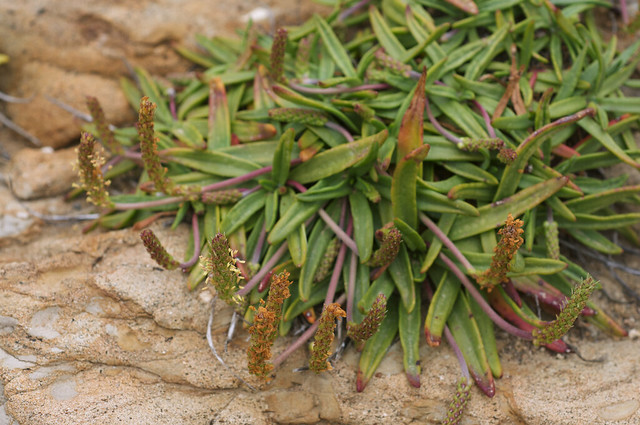
Use the young leaves raw in salads, or cooked in soups, in mixed cooked greens, or in any dish that calls for cooking greens. Goosetongue is best in spring and early summer, before the flowers appear. Goosetongue can be confused with poisonous Arrowgrass, so careful identification is essential. Goosetongue is also called Seashore Plantain.
Joe Pye Weed - Eutrochium
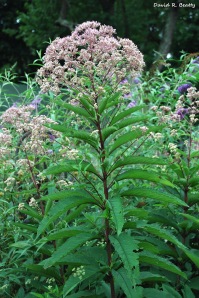
Edible parts: The entire plant can be used including the root. The leaves and stems can be harvested in the summer before the flower buds open and can be dried and stored for later use. The roots are harvested in the autumn. Fresh flowers can be used to make an herbal tea.
Joe Pye weed is named after a legendary Indian healer who used a decoction of the plant to cure typhus fever in colonial America. Native tribes used gravel root as a healing tonic included relieving constipation, washing wounds with a strong tea made from the root to prevent infection.
Similar to coltsfoot, Joe Pye weed contains livertoxic PAs which might be carcinogenic.
Pigweed - Amaranthus palmeri
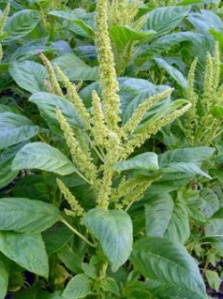
Edible parts: The whole plant – leaves, roots, stem, seeds. The Amarath seed is small and very nutritious and easy to harvest, the seed grain is used to make flour for baking uses. Roasting the seeds can enhance the flavor, also you can sprout the raw seeds using them in salads, and in sandwiches, etc. Young leaves can be eaten raw or cooked like spinach, sautéed, etc. Fresh or dried pigweed leaves can be used to make tea.
Fireweed - Chamerion angustifolium
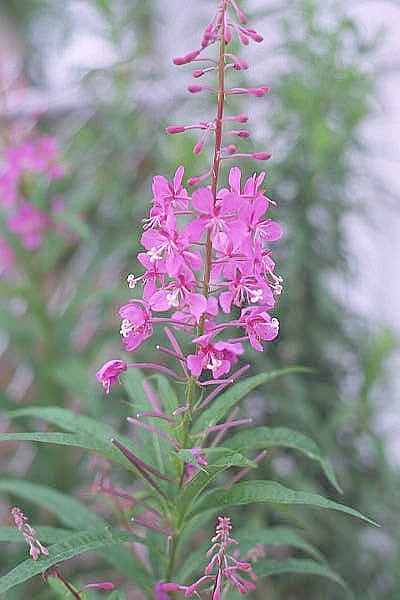
This pretty little plant is found primarily in the Northern Hemisphere. You can identify fireweed by its purple flower and the unique structure of the leaves' veins; the veins are circular rather than terminating on the edges of the leaves. Several Native American tribes included fireweed in their diet. It's best eaten young when the leaves are tender. Mature fireweed plants have tough and bitter tasting leaves. You can eat the stalk of the plant as well. The flowers and seeds have a peppery taste. Fireweed is a great source of vitamins A and C.
Monkey Flower - Mimulus

Use the leaves raw in salads, or cooked in soups, mixed cooked greens, or any dish that calls for cooking greens. Monkey flower is best before the flowers appear, although the flowers are also edible and are good in salads or as a garnish.
Self-heal - Prunella vulgaris

Edible parts: the young leaves and stems can be eaten raw in salads; the whole plant can be boiled and eaten as a potherb; and the aerial parts of the plant can be powdered and brewed in a cold infusion to make a tasty beverage. The plant contains vitamins A, C, and K, as well as flavonoids and rutin. Medicinally, the whole plant is poulticed onto wounds to promote healing. A mouthwash made from an infusion of the whole plant can be used to treat sore throats, thrush and gum infections. Internally, a tea can be used to treat diarrhea and internal bleeding.
Shepherd's Purse - Capsella bursa-pastoris
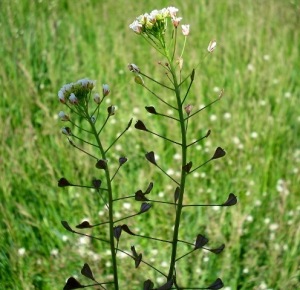
Use the young leaves raw in salads, or cooked in soups, in mixed cooked greens or in any dish that calls for cooking greens. Although the leaves may be eaten throughout the summer, the mature leaves have a peppery taste that does not appeal to all palates.
Common Mallow – Malva neglecta
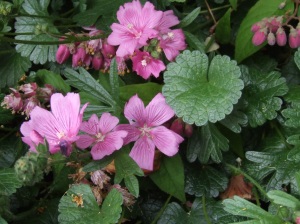
Edible parts:All parts of the mallow plant are edible — the leaves, the stems, the flowers, the seeds, and the roots (it's from the roots that cousin Althaea gives the sap that was used for marshmallows). Because it's a weed that grows plentifully in neglected areas, mallows have been used throughout history as a survival food during times of crop failure or war. Mallows are high in mucilage, a sticky substance that gives them a slightly slimy texture, similar to okra, great in soups. Mallow has a nice pleasant nutty flavor. One of the most popular uses of mallows is as a salad green.
Miner's Lettuce - Claytonia perfoliata
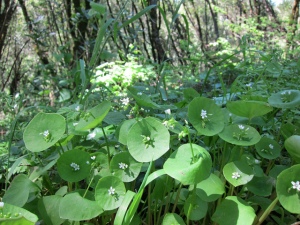
Parts: Flowers, Leaves, Root. Leaves can be eaten raw or cooked. A fairly bland flavor with a mucilaginous texture, it is quite nice in a salad. The young leaves are best, older leaves can turn bitter especially in the summer and if the plant is growing in a hot dry position. Although individual leaves are fairly small, they are produced in abundance and are easily picked. Stalks and flowers can be eaten raw. A nice addition to the salad bowl. Bulb also can be eaten raw. Although very small and labor-intensive to harvest, the boiled and peeled root has the flavor of chestnuts. Another report says that the plant has a fibrous root system so this report seems to be erroneous.
Field Pennycress - Thlaspi arvense
Field Pennycress is a weed found in most parts of the world. Its growing season is early spring to late winter. You can eat the seeds and leaves of field pennycress raw or boiled. The only caveat with field pennycress is not to eat it if it's growing in contaminated soil. Pennycress is a hyperaccumulator of minerals, meaning it sucks up any and all minerals around it. General rule is don't eat pennycress if it's growing by the side of the road or is near a Superfund site.
Sweet Rocket - Hesperis matronalis

This plant is often mistaken for Phlox. Phlox has five petals, Dame's Rocket has just four. The flowers, which resemble phlox, are deep lavender, and sometimes pink to white. The plant is part of the mustard family, which also includes radishes, broccoli, cabbage, cauliflower, and, mustard. The plant and flowers are edible, but fairly bitter. The flowers are attractive added to green salads. The young leaves can also be added to your salad greens (for culinary purposes, the leaves should be picked before the plant flowers). The seed can also be sprouted and added to salads. NOTE: It is not the same variety as the herb commonly called Rocket, which is used as a green in salads.
Wild Bee Balm - Monarda fistulosa

Edible parts: Leaves boiled for tea, used for seasoning, chewed raw or dried; flowers edible. Wild bee balm tastes like oregano and mint. The taste of bee balm is reminiscent of citrus with soft mingling of lemon and orange. The red flowers have a minty flavor. Any place you use oregano, you can use bee balm blossoms. The leaves and flower petals can also be used in both fruit and regular salads. The leaves taste like the main ingredient in Earl Gray Tea and can be used as a substitute.
Mallow is a soft tasty leaf good in fresh salads. Use it like lettuce and other leafy greens. You may find the smaller younger leaves a tad more tender. Toss in salads, or cook as you would other tender greens like spinach. The larger leave can be used for stuffing, like grape leaves. The seed pods are also edible while green and soft before they harden, later turning woody and brown. I hear they can be cooked like a vegetable. I've harvested and eaten them raw, and want to try steaming, pickling, fermenting, and preparing like ocra.
Pineapple Weed - Matricaria discoidea
Edible parts: Pineapple weed flowers and leaves are a tasty finger food while hiking or toss in salads. Flowers can also be dried out and crushed so that it can be used as flour. As with chamomile, pineapple weed is very good as a tea. Native Americans used a leaf infusion (medicine prepared by steeping flower or leaves in a liquid without boiling) for stomach gas pains and as a laxative.
Milk Thistle - Silybum marianum
Milk thistle is most commonly sought for its medicial properties of preventing and repairing liver damage. But most parts of the plants are also edible and tasty. Until recently, it was commonly cultivated in Eurpoean vegetable gardens. Leaves can be de-spined for use as salad greens or sautéed like collard greens; water-soaked stems prepared like asparugus; roots boiled or baked; flower pods used like artichoke heads.
Prickly Pear Cactus - Opuntia
Found in the deserts of North America, the prickly pear cactus is a very tasty and nutritional plant that can help you survive the next time you're stranded in the desert. The fruit of the prickly pear cactus looks like a red or purplish pear. Hence the name. Before eating the plant, carefully remove the small spines on the outer skin or else it will feel like you're swallowing a porcupine. You can also eat the young stem of the prickly pear cactus. It's best to boil the stems before eating.
Common Mullein – Verbascum thapsus

Edible parts: Leaves and flowers. The flowers are fragrant and taste sweet, the leaves are not fragrant and taste slightly bitter. This plant is best known for a good cup of tea and can be consumed as a regular beverage. Containing vitamins B2, B5, B12, and D, choline, hesperidin, para amino benzoic acid, magnesium, and sulfur, but mullein tea is primarily valued as an effective treatment for coughs and lung disorders.
Wild Grape Vine - Ampelocissus acetosa

Edible parts: Grapes and leaves. The ripe grape can be eaten but tastes better after the first frost. Juicing the grapes or making wine is most common. The leaves are also edible. A nutritional mediterranean dish called "dolmades", made from grape leaves are stuffed with rice, meat and spices. The leaves can be blanched and frozen for use throughout the winter months.
Yellow Rocket - Barbarea

It tends to grow in damp places such as hedges, stream banks and waysides and comes into flower from May to August. Yellow Rocket was cultivated in England as an early salad vegetable. It makes a wonderful salad green when young and the greens are also an excellent vegetable if treated kindly. Lightly steam or gently sweat in butter until just wilted. The unopened inflorescences can also be picked and steamed like broccoli.
Purslane - Portulaca oleracea
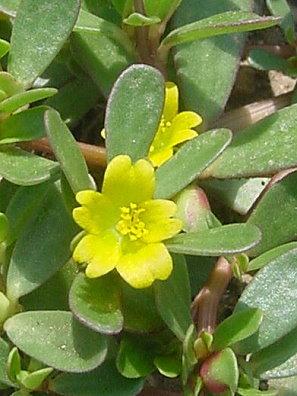
While considered an obnoxious weed in the United States, purslane can provide much needed vitamins and minerals in a wilderness survival situation. Ghandi actually numbered purslane among his favorite foods. It's a small plant with smooth fat leaves that have a refreshingly sour taste. Purslane grows from the beginning of summer to the start of fall. You can eat purslane raw or boiled. If you'd like to remove the sour taste, boil the leaves before eating.
Sheep Sorrel - Rumex acetosella

Sheep sorrel is native to Europe and Asia but has been naturalized in North America. It's a common weed in fields, grasslands, and woodlands. It flourishes in highly acidic soil. Sheep sorrel has a tall, reddish stem and can reach heights of 18 inches. Sheep sorrel contains oxalates and shouldn't be eaten in large quantities. You can eat the leaves raw. They have a nice tart, almost lemony flavor.
Wild Mustard - Brassica campestris

Wild mustard is found in the wild in many parts of the world. It blooms between February and March. You can eat all parts of the plant- seeds, flowers, and leaves.
Wood Sorrel - Oxalis
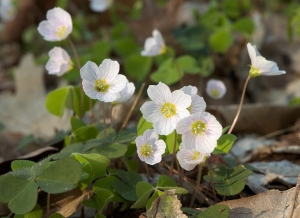
You'll find wood sorrel in all parts of the world; species diversity is particularly rich in South America. Humans have used wood sorrel for food and medicine for millennia. The Kiowa Indians chewed on wood sorrel to alleviate thirst, and the Cherokee ate the plant to cure mouth sores. The leaves are a great source of vitamin C. The roots of the wood sorrel can be boiled. They're starchy and taste a bit like a potato.
-if you do not water it properly-









































